Forest Plantations’ Externalities: An Application of the Analytic Hierarchy Process to Non-Industrial Forest Owners in Central Chile
Abstract
:1. Introduction
- a very strong land concentration in which almost half of forest plantations and much of the national wood production and export are controlled by three large private companies [11]. The two national enterprises Arauco and CMPC (Compañía Manufacturera de Papeles y Cartones) possess 33.1% and 17.4% of the forest plantations surface, respectively, while Masisa, an international enterprise, owns 1.7% of Chilean forest plantations (own elaboration [12,13,14]). The contribution of the three companies to exports is 49.7% for Arauco, 15.7% for CMPC, and 8.7% for Masisa [15];
- at the same time, because of the economic concentration, these firms exert their market power over price (forest products and land) and wages. In this way, small and medium forest owners are negatively affected by the resulting market distortions inasmuch as they became less competitive [5].
2. Study Area
3. Research Methodology
3.1. Preliminary Identification of Externalities
3.2. Experts Consultation
3.3. Experts’ Response Indicator Elaboration
3.4. Forest Owners’ Perception Estimated with the Analytic Hierarchy Process (AHP) Technique
4. Results and Discussion
4.1. Preliminary Identification of Externalities
4.2. Experts Response Indicator
4.3. Local Differences among Forest Owners’ Perception
5. Conclusions
Supplementary Materials
Acknowledgments
Author Contributions
Conflicts of Interest
Appendix A
| Category | Externality | |
|---|---|---|
| Environmental externalities | Negative | Water shortage [17,20,21,53,56,57] |
| Water pollution [22,58] | ||
| Degradation of native forest [18,19,20,21,23,53,59] | ||
| Native forest loss [20,53,60] | ||
| Biodiversity decrease [21,53] | ||
| Landscape simplification [59] | ||
| Contamination by pesticides [8,17,44] | ||
| Soil degradation [11,21,23,44,53] | ||
| Positive | Pressure reduction on natural forests [44,58] | |
| Increase of ecosystem services [59,61] | ||
| CO2 sequestration [62] | ||
| Increasing of infiltration and water storage [63] | ||
| Biodiversity increase [64] | ||
| Soil erosion control [58,59] | ||
| Social externalities | Negative | Increase of migration [11,20,21,59,65,66] |
| Health problems (pesticides) [11,21,22,53] | ||
| Increase of accidents (without specialized worker) [11] | ||
| Breaking of the peasant systems (culture, identity) [21,51,53] | ||
| Threatened local livelihoods [22,51] | ||
| End of local use of natural resources [11,21,53] | ||
| Isolation of rural population [5] | ||
| Decrease of local development [11] | ||
| Power asymmetry (employment by contractor) [11,22] | ||
| Gender inequality [11,58] | ||
| Increase of conflicts [67] | ||
| Land tenure conflict [21,58] | ||
| Increased rate of road accidents [65] | ||
| Positive | Increase of direct and indirect employment [11,68,69] | |
| Safety in working sites [70] | ||
| Improvement of livelihood [71] | ||
| Improvement of education and healthcare facilities [69] | ||
| Improvement of infrastructures [69] | ||
| Increased connectivity (improvement of road network) [71] | ||
| Access to plantation resources (firewood, NTFP) [72] | ||
| Increase of social capital [72] | ||
| Economic externalities | Negative | Increased poverty rate [24] |
| Diminished economic opportunities [11,24] | ||
| Less employment opportunities [24] | ||
| Only modest employment offered [11,21,59] | ||
| Casual and poorly paid jobs (contractors) [11,59] | ||
| Greater reliance on hired labour [73] | ||
| Difficulties in trading native timber (dumping) [5] | ||
| Income decrease [22,68] | ||
| Inequality in distribution of plantation benefits [59] | ||
| Land loss [22,69] | ||
| Positive | Economy improvement [58] | |
| Creation of business cluster [74] | ||
| Improvement of trading activities [75] | ||
| More importance of small and medium forest owners [59] | ||
Appendix B
| Category | Environmental Externalities | Panel of Experts (n = 15) | ERI (%) | |||||
|---|---|---|---|---|---|---|---|---|
| Number of Respondents by Mark | ||||||||
| Not Important 0 | Slightly Important 1 | Moderately Important 2 | Important 3 | Very Important 4 | Extremely Important 5 | |||
| Positive Externalities | Soil erosion control | 1 | 2 | 2 | 3 | 3 | 4 | 62.7 |
| CO2 sequestration | 0 | 4 | 4 | 3 | 2 | 2 | 52.0 | |
| Pressure reduction on natural forests | 1 | 5 | 3 | 5 | 0 | 1 | 41.3 | |
| Increasing of infiltration and water storage | 3 | 5 | 2 | 3 | 2 | 0 | 34.7 | |
| Increase of ecosystem services | 3 | 4 | 5 | 2 | 1 | 0 | 32.0 | |
| Biodiversity increase | 3 | 7 | 4 | 0 | 1 | 0 | 25.3 | |
| Negative Externalities | Landscape simplification | 0 | 1 | 2 | 5 | 5 | 2 | 66.7 |
| Biodiversity decrease | 0 | 1 | 3 | 7 | 2 | 2 | 61.3 | |
| Water shortage | 1 | 2 | 2 | 4 | 3 | 3 | 60.0 | |
| Native forest loss | 2 | 2 | 2 | 5 | 2 | 2 | 52.0 | |
| Water pollution | 2 | 3 | 5 | 2 | 1 | 2 | 44.0 | |
| Contamination by pesticides | 2 | 2 | 5 | 3 | 1 | 1 | 42.9 | |
| Degradation of native forest | 0 | 8 | 2 | 1 | 3 | 1 | 42.7 | |
| Soil degradation | 4 | 4 | 3 | 1 | 3 | 0 | 33.3 | |
| Category | Social Externalities | Panel of Experts (n = 15) | ERI (%) | |||||
|---|---|---|---|---|---|---|---|---|
| Number of Respondents by Mark | ||||||||
| Not Important 0 | Slightly Important 1 | Moderately Important 2 | Important 3 | Very Important 4 | Extremely Important 5 | |||
| Positive Externalities | Increased connectivity (improvement of road network) | 1 | 2 | 1 | 5 | 2 | 4 | 62.7 |
| Increase of direct and indirect employment | 0 | 3 | 2 | 7 | 2 | 1 | 54.7 | |
| Improvement of livelihood | 0 | 4 | 2 | 7 | 1 | 1 | 50.7 | |
| Improvement of infrastructures | 1 | 4 | 4 | 1 | 3 | 2 | 49.3 | |
| Access to plantation resources (firewood, NTFP) | 1 | 5 | 1 | 5 | 3 | 0 | 45.3 | |
| Improvement of education and healthcare facilities | 2 | 5 | 5 | 0 | 1 | 2 | 38.7 | |
| Safety in working sites | 1 | 5 | 4 | 5 | 0 | 0 | 37.3 | |
| Increase of social capital | 2 | 7 | 2 | 3 | 1 | 0 | 32.0 | |
| Negative Externalities | Increase of migration | 0 | 4 | 2 | 3 | 5 | 1 | 56.0 |
| Power asymmetry (employment by contractor) | 0 | 4 | 4 | 1 | 6 | 0 | 52.0 | |
| Breaking of the peasant systems (culture, identity) | 0 | 5 | 1 | 5 | 4 | 0 | 50.7 | |
| Gender inequality | 1 | 3 | 4 | 3 | 3 | 1 | 49.3 | |
| Threatened local livelihoods | 1 | 2 | 4 | 6 | 2 | 0 | 48.0 | |
| Land tenure conflict | 0 | 4 | 5 | 3 | 2 | 1 | 48.0 | |
| Decreased local development | 1 | 5 | 4 | 1 | 2 | 2 | 45.3 | |
| Increase of conflict | 0 | 5 | 4 | 5 | 0 | 1 | 44.0 | |
| Increased rate of road accidents | 1 | 4 | 5 | 2 | 3 | 0 | 42.7 | |
| Increase of accidents (without specialized worker) | 1 | 5 | 4 | 3 | 1 | 1 | 41.3 | |
| Isolation of rural population | 3 | 5 | 3 | 0 | 4 | 0 | 36.0 | |
| Health problems (pesticides) | 2 | 5 | 5 | 1 | 2 | 0 | 34.7 | |
| End of local use of natural resources | 3 | 3 | 6 | 2 | 0 | 1 | 34.7 | |
| Category | Economic Externality | Panel of Experts (n = 15) | ERI (%) | |||||
|---|---|---|---|---|---|---|---|---|
| Number of Respondents by Mark | ||||||||
| Not Important 0 | Slightly Important 1 | Moderately Important 2 | Important 3 | Very Important 4 | Extremely Important 5 | |||
| Positive Externalities | Economy improvement | 0 | 1 | 1 | 9 | 2 | 2 | 64.0 |
| Improvement of trading activities | 1 | 1 | 3 | 7 | 1 | 2 | 56.0 | |
| More importance of small and medium forest owners | 2 | 4 | 1 | 4 | 4 | 0 | 45.3 | |
| Creation of business cluster | 1 | 4 | 5 | 3 | 2 | 0 | 41.3 | |
| Negative Externalities | Inequality in distribution of plantation benefits | 0 | 1 | 4 | 2 | 5 | 3 | 66.7 |
| Casual and poorly paid jobs (contractors) | 2 | 1 | 2 | 4 | 4 | 2 | 57.3 | |
| Land loss | 1 | 2 | 3 | 2 | 4 | 2 | 57.1 | |
| Only modest employment offered | 2 | 2 | 1 | 5 | 3 | 2 | 54.7 | |
| Greater reliance on hired labour | 0 | 3 | 6 | 2 | 3 | 1 | 50.7 | |
| Increased poverty rate | 1 | 4 | 2 | 7 | 0 | 1 | 45.3 | |
| Diminished economic opportunities offered | 1 | 4 | 4 | 3 | 3 | 0 | 44.0 | |
| Less employment opportunities | 1 | 5 | 3 | 3 | 3 | 0 | 42.7 | |
| Income decrease | 2 | 4 | 5 | 2 | 2 | 0 | 37.3 | |
| Difficulties in trading native timbers (dumping) | 2 | 7 | 2 | 1 | 2 | 1 | 36.0 | |
References
- Sargent, C.; Bass, S. Plantation Politics: Forest Plantations in Development; Abingdon-on-Thames: Routledge, UK, 2013; ISBN 978-1-134-06470-0. [Google Scholar]
- Lara, A.; Solari, M.E.; Prieto, M.D.R.; Peña, M.P. Reconstrucción de la cobertura de la vegetación y uso del suelo hacia 1550 y sus cambios a 2007 en la ecorregión de los bosques valdivianos lluviosos de Chile (35°–43° 30′ S). Bosque (Valdivia) 2012, 33, 13–23. [Google Scholar] [CrossRef]
- Infor: Estadisticas Forestales Anuario Forestal. 2016. Available online: http://wef.infor.cl/publicaciones/anuario/2016/Anuario2016.pdf (accessed on 18 November 2017).
- Lara, A.; Veblen, T. Forest plantations in Chile: A successful model? In Afforestation: Policies, Planning, and Progress; Mather, A., Ed.; Belhaven Press: London, UK, 1993; pp. 118–139. [Google Scholar]
- Reyes, R.; Nelson, H. A tale of two forests: Why forests and forest conflicts are both growing in Chile. Int. For. Rev. 2014, 16. [Google Scholar] [CrossRef]
- Cossalter, C.; Pye-Smith, C. Fast-Wood Forestry. Myths and Realities; CIFOR: Bogor, Indonesia, 2003; ISBN 979-3361-09-3. [Google Scholar]
- Salas, C.; Donoso, P.; Vargas, G.R.; Arriagada, C.; Pedraza, R.; Soto, D. The forest sector in Chile: An overview and current challenges. J. For. 2016, 114, 562–571. [Google Scholar] [CrossRef]
- Neilson, D.A.; Evans, J. Planted Forest: Uses, Impacts and Sustainability; FAO and CAB International: Roma, Italy, 2009; Chapter 7; ISBN 978-1-84593-564-1. [Google Scholar]
- Biblioteca del Congreso Nacional de. M. D. DL-701 28 November 1974 Ministerio de Agricultura. Available online: https://www.leychile.cl/Navegar?idNorma=6294&idParte= (accessed on 18 November 2017).
- Reyes, R.; Sepúlveda, C.; Astorga, L. Gobernanza del sector forestal chileno. Tensiones y conflictos entre las fuerzas de mercado y las demandas de la ciudadanía. In Ecología Forestal. Bases Para el Manejo Sustentable y Conservación de los Bosques Nativos de Chile, 1st ed.; Donoso, C., González, M., Lara, A., Eds.; Universidad Austral de Chile: Valdivia, Chile, 2014; pp. 693–720. [Google Scholar]
- OIT. El Trabajo Decente en la Industria Forestal en Chile. Available online: http://www.ilo.org/santiago/publicaciones/WCMS_206093/lang--es/index.htm (accessed on 18 November 2017).
- Vial, S. Arauco. Reporte de Sostenibilidad 2016. Available online: https://www.arauco.cl/chile/wp-content/uploads/sites/14/2017/07/Reporte-Sostenibilidad-2016.pdf (accessed on 23 November 2017).
- CMPC. Reporte Integrado 2016. Available online: http://s21.q4cdn.com/798526818/files/doc_financials/Integrated_report/CMPC-Integrated-Report-2016.pdf (accessed on 23 November 2017).
- Masisa. Memoria Annual 2016. Available online: http://www.masisa.com/wp-content/files_mf/1491859532memoriaanual2016.pdf (accessed on 23 November 2017).
- Gysling Caselli, J.; Soto Aguirre, D. Infor. Industria Forestal Primaria en Chile. Período 2006–2015. 2016. Available online: http://wef.infor.cl/publicaciones/industria_primaria/2017/IP2017.pdf (accessed on 23 November 2017).
- Leyton Vásquez, J. Tenencia Forestal en Chile. 2009. Available online: http://www.fao.org/forestry/17192-0422df95bf58b971d853874bb7c5755f7.pdf (accessed on 18 November 2017).
- Little, C.; Lara, A.; McPhee, J.; Urrutia, R. Revealing the impact of forest exotic plantations on water yield in large scale watersheds in South-Central Chile. J. Hydrol. 2009, 374, 162–170. [Google Scholar] [CrossRef]
- Miranda, A.; Altamirano, A.; Cayuela, L.; Lara, A.; González, M. Native forest loss in the Chilean biodiversity hotspot: Revealing the evidence. Reg. Environ. Chang. 2017, 17, 285–297. [Google Scholar] [CrossRef]
- Nahuelhual, L.; Carmona, A.; Lara, A.; Echeverría, C.; González, M.E. Land-cover change to forest plantations: Proximate causes and implications for the landscape in south-central Chile. Landsc. Urban Plan. 2012, 107, 12–20. [Google Scholar] [CrossRef]
- Araya Cornejo, J. OLCA. La Invasión de Las Plantaciones Forestales en Chile. Efectos de la Actividad Forestal en la Población Indígena Mapuche. 2003. Available online: http://www.olca.cl/oca/chile/plantacion.pdf (accessed on 18 November 2017).
- Montalba Navarro, R.; Carrasco, H.N.; Araya Cornejo, J. OLCA. Contexto Económico y Social de las Plantaciones Forestales en Chile. 2005. Available online: http://www.olca.cl/oca/informes/librolumaco.pdf (accessed on 18 November 2017).
- Gerber, J.F. Conflicts over industrial tree plantations in the South: Who, how and why? Glob. Environ. Chang. 2011, 21, 165–176. [Google Scholar] [CrossRef]
- Roco, L.; Engler, A.; Jara-Rojas, R. Factores que Influyen en la Adopción de tecnologías de conservación de suelos en el secano interior de Chile Central. Revista Facultad Ciencias Agrarias 2012, 44, 31–45. [Google Scholar]
- Andersson, K.; Lawrence, D.; Zavaleta, J.; Guariguata, M.R. More trees, more poverty? The socioeconomic effects of tree plantations in Chile, 2001–2011. Environ. Manag. 2016, 57, 123–136. [Google Scholar] [CrossRef] [PubMed]
- CONAF. Sistema de Informacion Territorial. Available online: https://sit.conaf.cl/ (accessed on 18 November 2017).
- Yáñez Barrios, L. ODEPA. Fichas Nacional y Regionales, Análisis Censales y Catastros. Región del Maule. Información Regional 2016. Available online: http://www.odepa.cl/estadisticas/censos-y-catastros/ (accessed on 18 November 2017).
- Zonas Rezagadas. Available online: http://www.zonasrezagadas.subdere.gov.cl/pages/documentos (accessed on 18 November 2017).
- San Martín, J.; Donoso, C.; Armestó, J.J.; Villagrán, C.; Kalin Arroyo, M. Estructura florística e impacto antrópico en el bosque maulino de Chile. In Ecología de Los Bosques Nativos de Chile; Armesto, J., Villagrán, C., Arroyo, M., Eds.; Editorial Universitaria: Santiago, Chile, 1997; pp. 153–168. [Google Scholar]
- Díaz-Hormazábal, I.; González, M. Análisis espacio-temporal de incendios forestales en la región del Maule, Chile. Bosque (Valdivia) 2016, 37, 147–158. [Google Scholar] [CrossRef]
- IDE Minagri. Visor Ministerial. Available online: http://ide2.minagri.gob.cl/publico2/ (accessed on 18 November 2017).
- SII. Estadísticas de Empresas. Available online: http://www.sii.cl/estadisticas/empresas_rubro.htm#2 (accessed on 18 November 2017).
- Roco, L.; Engler, A.; Bravo-Ureta, B.; Jara-Rojas, R. Farm level adaptation decisions to face climatic change and variability: Evidence from Central Chile. Environ. Sci. Policy 2014, 44, 86–96. [Google Scholar] [CrossRef]
- Cronbach, L.J. Coefficient alpha and the internal structure of tests. Psychometrika 1951, 16, 297–334. [Google Scholar] [CrossRef]
- Gliem, J.; Gliem, R. Calculating, Interpreting, and Reporting Cronbach’s Alpha Reliability Coefficient for Likert-Type Scales. In Proceedings of the Midwest Research to Practice Conference in Adult, Continuing, and Community Education, Columbus, OH, USA, 8–10 October 2003. [Google Scholar]
- Peterson, R.A. Meta-analysis of Cronbach’s Coefficient Alpha. J. Consum. Res. 1994, 21, 381–391. [Google Scholar] [CrossRef]
- Matell, M.S.; Jacoby, J. Is there an optimal number of alternatives for Likert Scale items? Study I: Reliability and validity. Educ. Psychol. Meas. 1971, 31, 657–674. [Google Scholar] [CrossRef]
- Saaty, T.L. A scaling method for priorities in hierarchical structures. J. Math. Psychol. 1977, 15, 234–281. [Google Scholar] [CrossRef]
- Ying, X.; Zeng, G.; Chen, G.; Tang, L.; Wang, K.; Huang, D. Combining AHP with GIS in synthetic evaluation of eco-environment quality—A case study of Hunan Province, China. Ecol. Model. 2007, 209, 97–109. [Google Scholar] [CrossRef]
- Gumus, S. An Evaluation of Stakeholder Perception Differences in Forest Road Assessment Factors Using the Analytic Hierarchy Process (AHP). Forests 2017, 8, 165. [Google Scholar] [CrossRef]
- Enescu, C.M. Wich are the most important non-wood forest products in the case of Ialomita County? Agrolife Sci. J. 2017, 6, 98–103. [Google Scholar]
- Eskandari, S. A new approach for forest fire risk modeling using fuzzy AHP and GIS in Hyrcanian forests of Iran. Arab. J. Geosci. 2017, 10. [Google Scholar] [CrossRef]
- Valls-Donderis, P.; Vallés-Planells, M.; Galiana, F. Short communication: AHP for indicators of sustainable forestry under Mediterranean conditions. For. Syst. 2017, 26. [Google Scholar] [CrossRef]
- Ramanathan, R. A note on the use of the analytic hierarchy process for environmental impact assessment. J. Environ. Manag. 2001, 63, 27–35. [Google Scholar] [CrossRef] [PubMed]
- The Montreal Process. Criteria and Indicators for Conservation and Sustainable Management of Temperate and Boreal Forest. 2015. Available online: https://www.montrealprocess.org/documents/publications/techreports/MontrealProcessSeptember2015.pdf (accessed on 11 January 2018).
- Saaty, T.L. Fundamentals of the Analytic Hierarchy Process. In The Analytic Hierarchy Process in Natural Resource and Environmental Decision Making; Managing Forest Ecosystems; Schmoldt, D.L., Kangas, J., Mendoza, G.A., Pesonen, M., Eds.; Springer: Dordrecht, The Netherlands, 2001; pp. 15–35. ISBN 978-90-481-5735-8. [Google Scholar]
- Triantaphyllou, E. Two new cases of rank reversals when the AHP and some of its additive variants are used that do not occur with the multiplicative AHP. J. Multi-Crit. Decis. Anal. 2001, 10, 11–25. [Google Scholar] [CrossRef]
- Kuenz Murphy, C. Limits on the analytic hierarchy process from its consistency index. Eur. J. Oper. Res. 1993, 65, 138–139. [Google Scholar] [CrossRef]
- Koczkodaj, W.W.; Orłowski, M. Computing a consistent approximation to a generalized pairwise comparisons matrix. Comput. Math. Appl. 1999, 37, 79–85. [Google Scholar] [CrossRef]
- Muñoz, M.; Aedo, D.; San Martín, J. Antecedentes sobre la recolección y comercialización de productos forestales no madereros (PFNM), en localidades rurales de la región del Maule, Chile central. Bosque (Valdivia) 2015, 36, 121–125. [Google Scholar] [CrossRef]
- Paulson, S. Desigualdad Social y Degradación Ambiental en América Latina; Abya Yala: Quito, Ecuador, 1998; ISBN 978-9978-04-441-4. [Google Scholar]
- Clapp, R.A. Regions of refuge and the agrarian question: Peasant agriculture and plantation forestry in Chilean araucanía. World Dev. 1998, 26, 571–589. [Google Scholar] [CrossRef]
- Infante, F. The role of social capital and labour exchange in the soils of Mediterranean Chile. Rural Soc. 2017, 26, 107–124. [Google Scholar] [CrossRef]
- GeografíaCrítica. Atlas Didáctico. Dimensión Socioambiental de los Conflictos Territoriales en Chile. Colectivo. Available online: http://www.geografiacritica.cl/descarga-atlas-didactico-dimension-socioambiental-de-los-conflictos-territoriales-en-chile (accessed on 18 November 2017).
- Higman, S.; Mayers, J.; Bass, S.; Judd, N.; Nussbaum, R. The Sustainable Forestry Handbook: A Practical Guide for Tropical Forest Managers on Implementing New Standards; Earthscan: London, UK, 2005; ISBN 1-84407-118-9. [Google Scholar]
- GIZ. Land Use Planning: Concepts, Tools and Applications. German Ministry of Economic Cooperation and Development. 2011. Available online: https://www.giz.de/fachexpertise/downloads/Fachexpertise/giz2012-en-land-use-planning-manual.pdf (accessed on 11 January 2018).
- Huber, A.; Iroumé, A.; Bathurst, J. Effect of Pinus radiata plantations on water balance in Chile. Hydrol. Process. 2008, 22, 142–148. [Google Scholar] [CrossRef]
- Huber, A.; Iroumé, A.; Mohr, C.; Frêne, C. Efecto de plantaciones de Pinus radiata y Eucalyptus globulus sobre el recurso agua en la Cordillera de la Costa de la región del Biobío, Chile. Bosque (Valdivia) 2010, 31, 219–230. [Google Scholar] [CrossRef]
- Tricallotis, M.; Kanowski, P. Tree Plantations in the Landscape Initiative: Background Paper for the Chile. Field Dialogue in Tree Plantations in the Landscape (TPL) in Chile. Available online: http://theforestsdialogue.org/dialogue/field-dialogue-tree-plantations-landscape-tpl-chile (accessed on 18 November 2017).
- Lamb, D. Large-Scale Forest Restoration; Routledge: New York, NY, USA, 2014; ISBN 9780415663182. [Google Scholar]
- Altamirano, A.; Aplin, P.; Miranda, A.; Cayuela, L.; Algar, A.C.; Field, R. High rates of forest loss and turnover obscured by classical landscape measures. Appl. Geogr. 2013, 40, 199–211. [Google Scholar] [CrossRef]
- Groot, R.; van der Meer, P.J. Quantifying and valuing goods and services provided by plantation forests. Ecosyst. Goods Serv. Plant. For. 2010. [Google Scholar] [CrossRef]
- IPCC. Summary for Policymakers. Fifth Assessment Report. In Mitigation of Climate Change. Available online: http://www.ipcc.ch/report/ar5/wg3/ (accessed on 18 November 2017).
- Van Dijk, A.I.J.M.; Keenan, R.J. Planted forests and water in perspective. For. Ecol. Manag. 2007, 251, 1–9. [Google Scholar] [CrossRef]
- Bremer, L.L.; Farley, K.A. Does plantation forestry restore biodiversity or create green deserts? A synthesis of the effects of land-use transitions on plant species richness. Biodivers. Conserv. 2010, 19, 3893–3915. [Google Scholar] [CrossRef]
- Schirmer, J. Plantations and social conflict: Exploring the differences between small-scale and large-scale plantation forestry. Small-Scale For. 2007, 6, 19–33. [Google Scholar] [CrossRef]
- Rudel, T.K. Tree farms: Driving forces and regional patterns in the global expansion of forest plantations. Land Use Policy 2009, 26, 545–550. [Google Scholar] [CrossRef]
- FAO. Global Forest Resources Assessment 2000. Main Report, Rome. Available online: ftp://ftp.fao.org/docrep/fao/003/y1997e/fra%202000%20main%20report.pdf (accessed on 18 November 2017).
- Untec. Actualización de Estudio Evaluación del Aporte Econpomico y Social del Sector Forestal en Chile y Analisis de Encadenamientos, Año 2014: Informe Final Para la Corporación Chilena de la Madera. Universidad y Tecnología Fundación Para la Transferencia Tecnológica. Available online: http://www.corma.cl/_file/material/evaluacion-del-aporte-economico-y-social-del-sector-forestal-2014.pdf (accessed on 18 November 2017).
- Bleyer, M.; Kniivilä, M.; Horne, P.; Sitoe, A.; Falcão, M.P. Socio-economic impacts of private land use investment on rural communities: Industrial forest plantations in Niassa, Mozambique. Land Use Policy 2016, 51, 281–289. [Google Scholar] [CrossRef]
- Beer, M.C.; de Ham, C.; Längin, D.W.; Theron, F. The socioeconomic impact of the phasing out of plantations in the Western and Southern Cape regions of South Africa. South. For. J. For. Sci. 2014, 76, 57–64. [Google Scholar] [CrossRef]
- Nath, T.K.; Inoue, M. Forest-based settlement project and its impacts on community livelihood in the Chittagong Hill Tracts, Bangladesh. Int. For. Rev. 2009, 11, 394–407. [Google Scholar] [CrossRef]
- Bisiaux, F.; Peltier, R.; Mulielie, J.C. Industrial plantation and agroforestry for the benefit of populations on the Bateke and Mampu Plateaux in the Democratic Republic of the Congo. Bois For. Trop. 2009, 301, 21–32. [Google Scholar] [CrossRef]
- Thulstrup, A.W. Plantation livelihoods in central Vietnam: Implications for household vulnerability and community resilience. Norsk Geogr. Tidsskr. Nor. J. Geogr. 2014, 68, 1–9. [Google Scholar] [CrossRef]
- Felzensztein, C.; Brodt, S.E.; Gimmon, E. Do strategic marketing and social capital really matter in regional clusters? Lessons from an emerging economy of Latin America. J. Bus. Res. 2014, 67, 498–507. [Google Scholar] [CrossRef]
- Nube, T.G.; Santos, A.S.J.D.; Timofeiczyk Junior, R.; Silva, I.C. Impactos socioeconômicos das plantações florestais no Niassa, Moçambique. Floresta Ambiente 2016, 23, 52–60. [Google Scholar] [CrossRef]
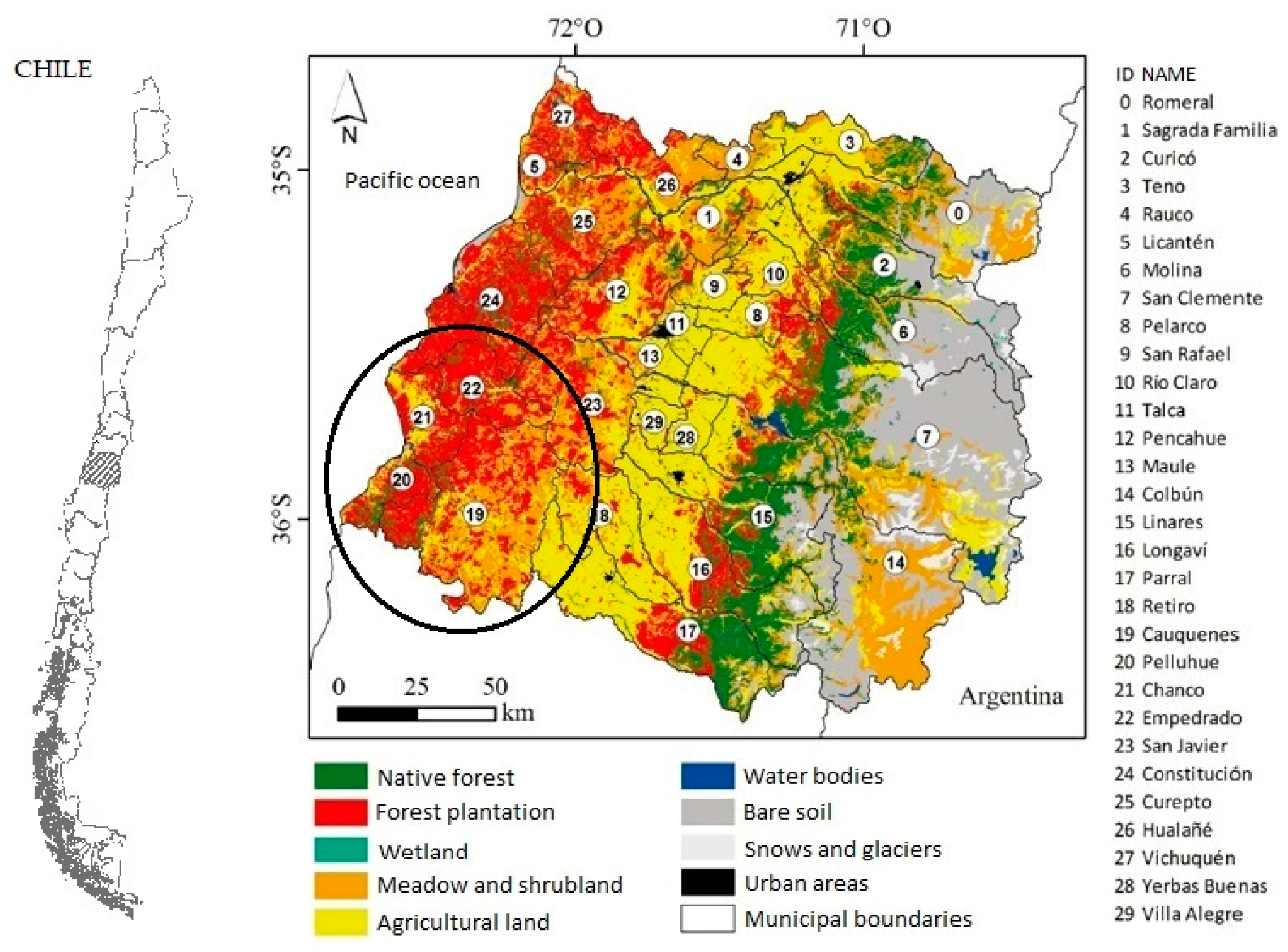
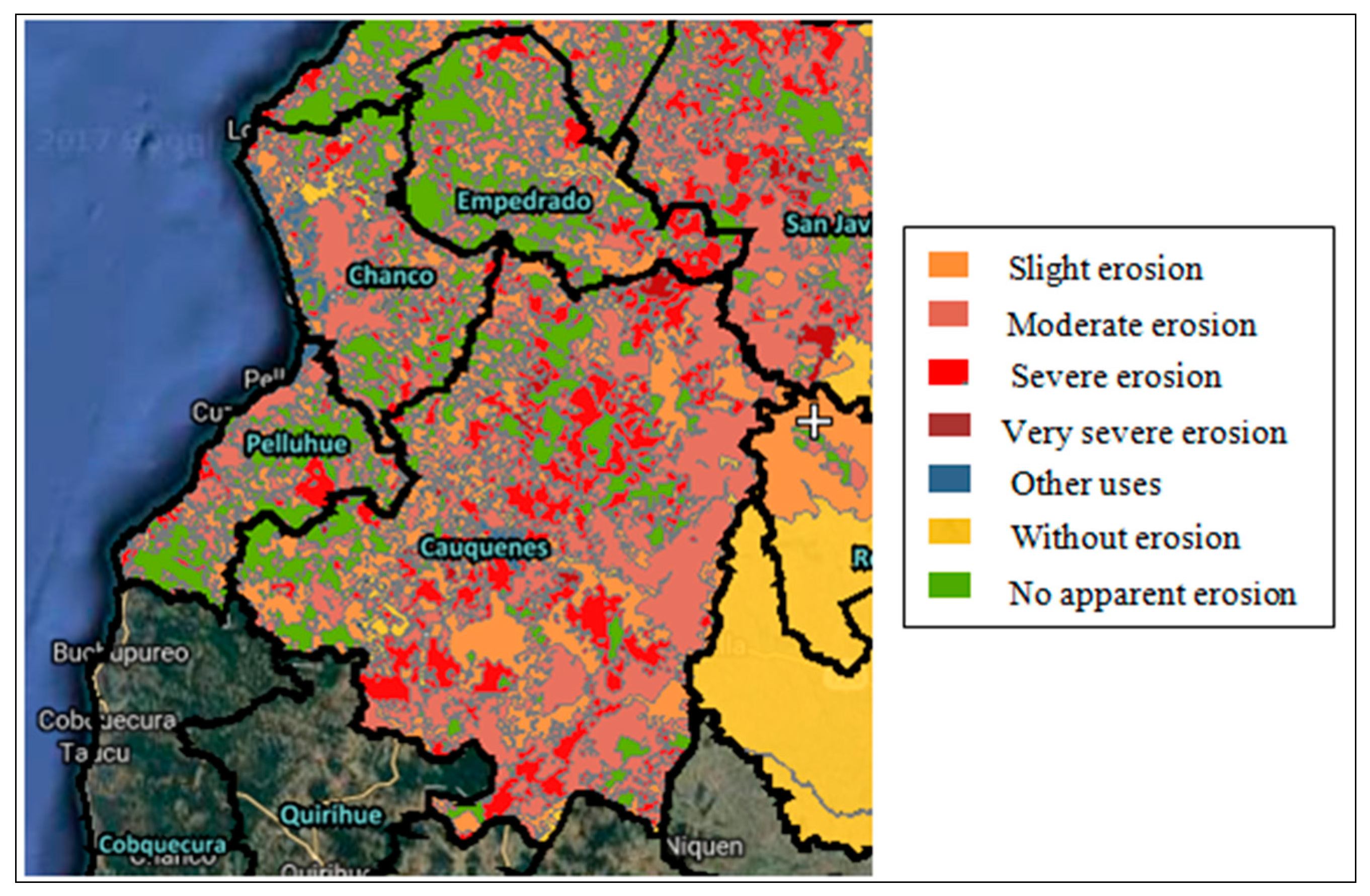
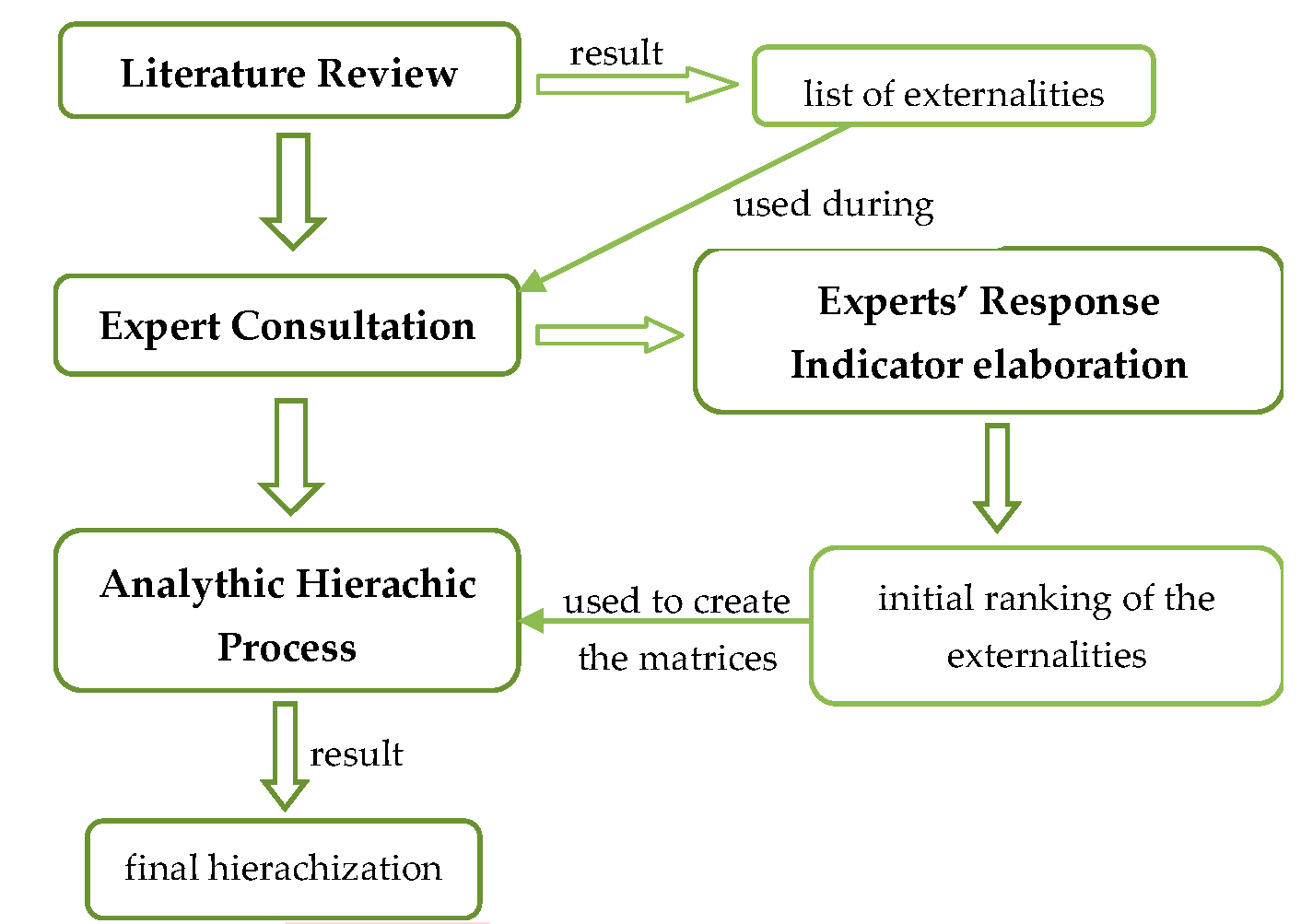
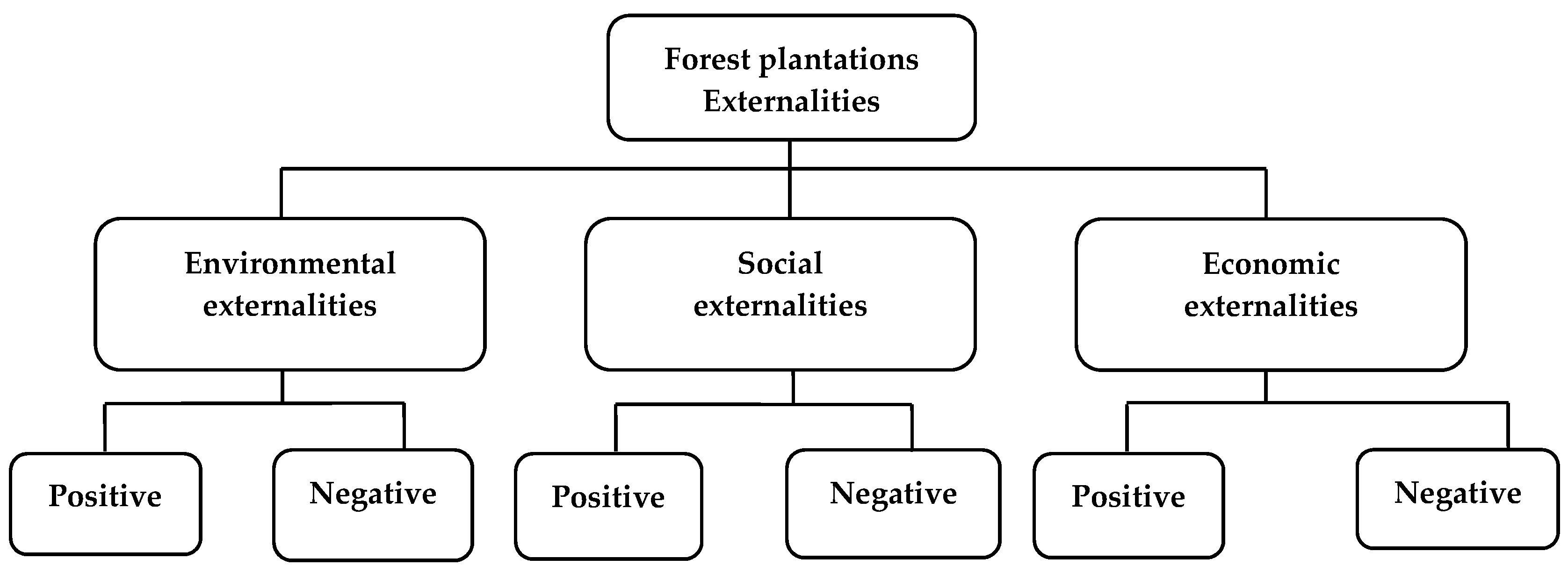
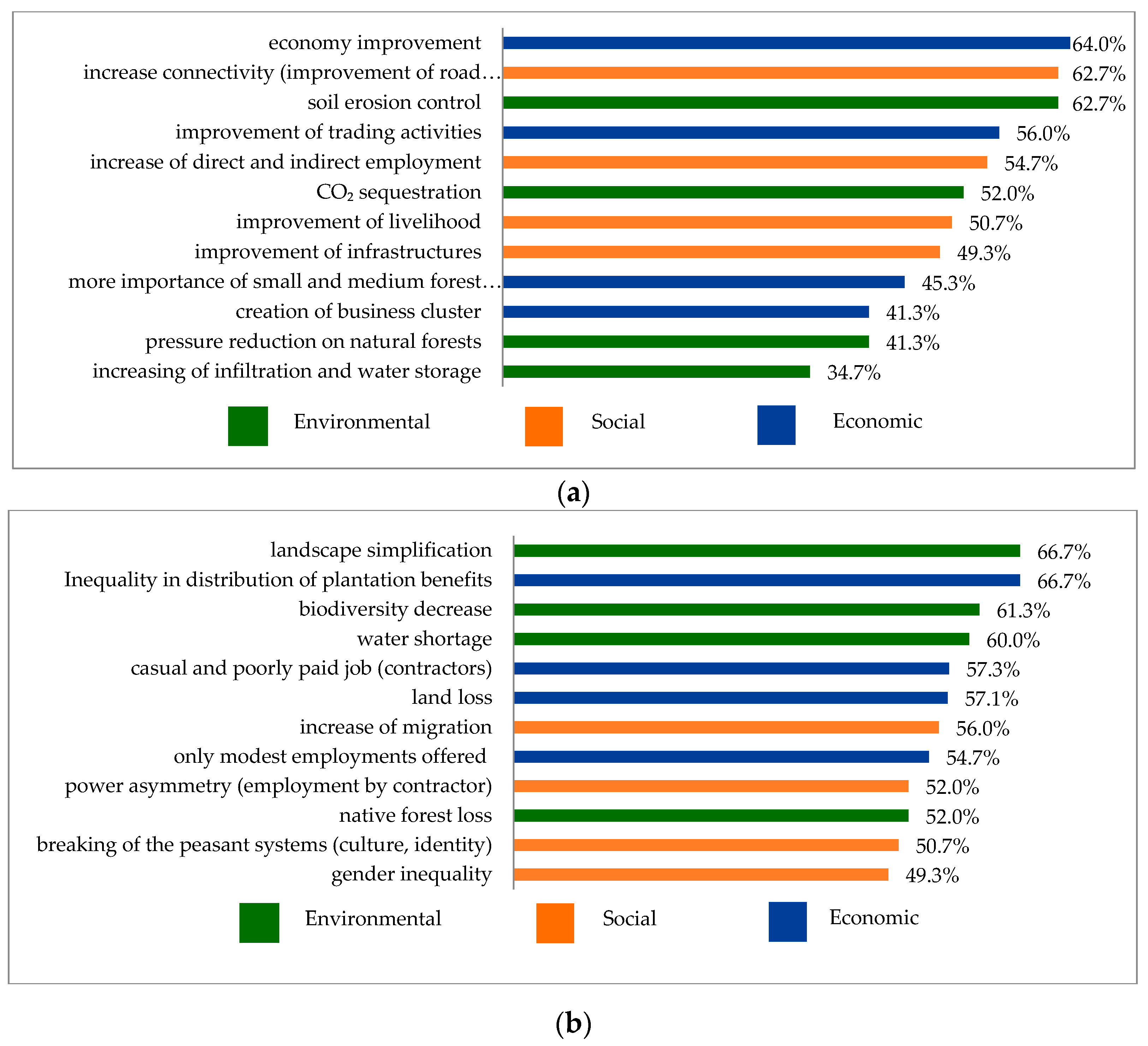

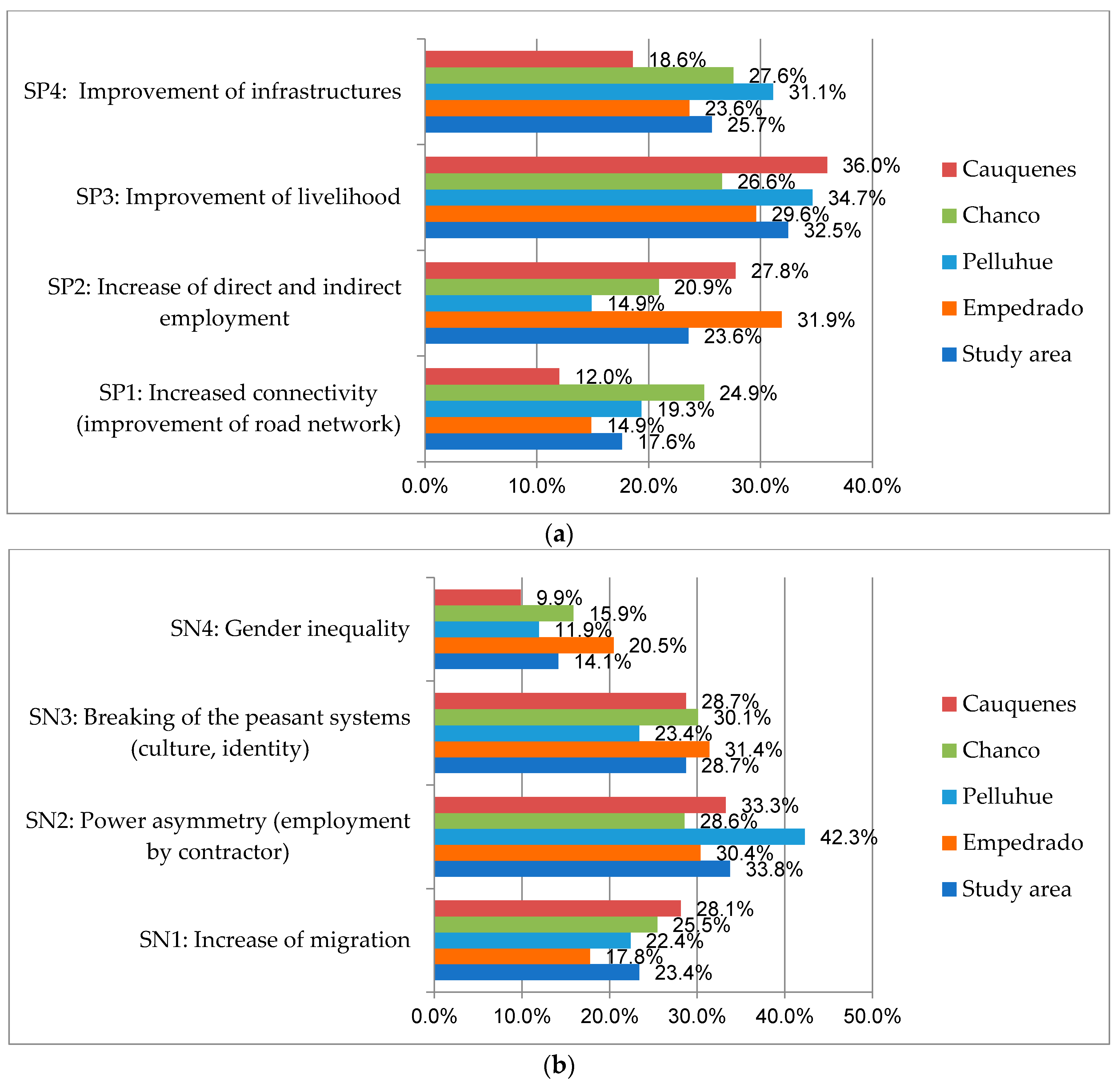
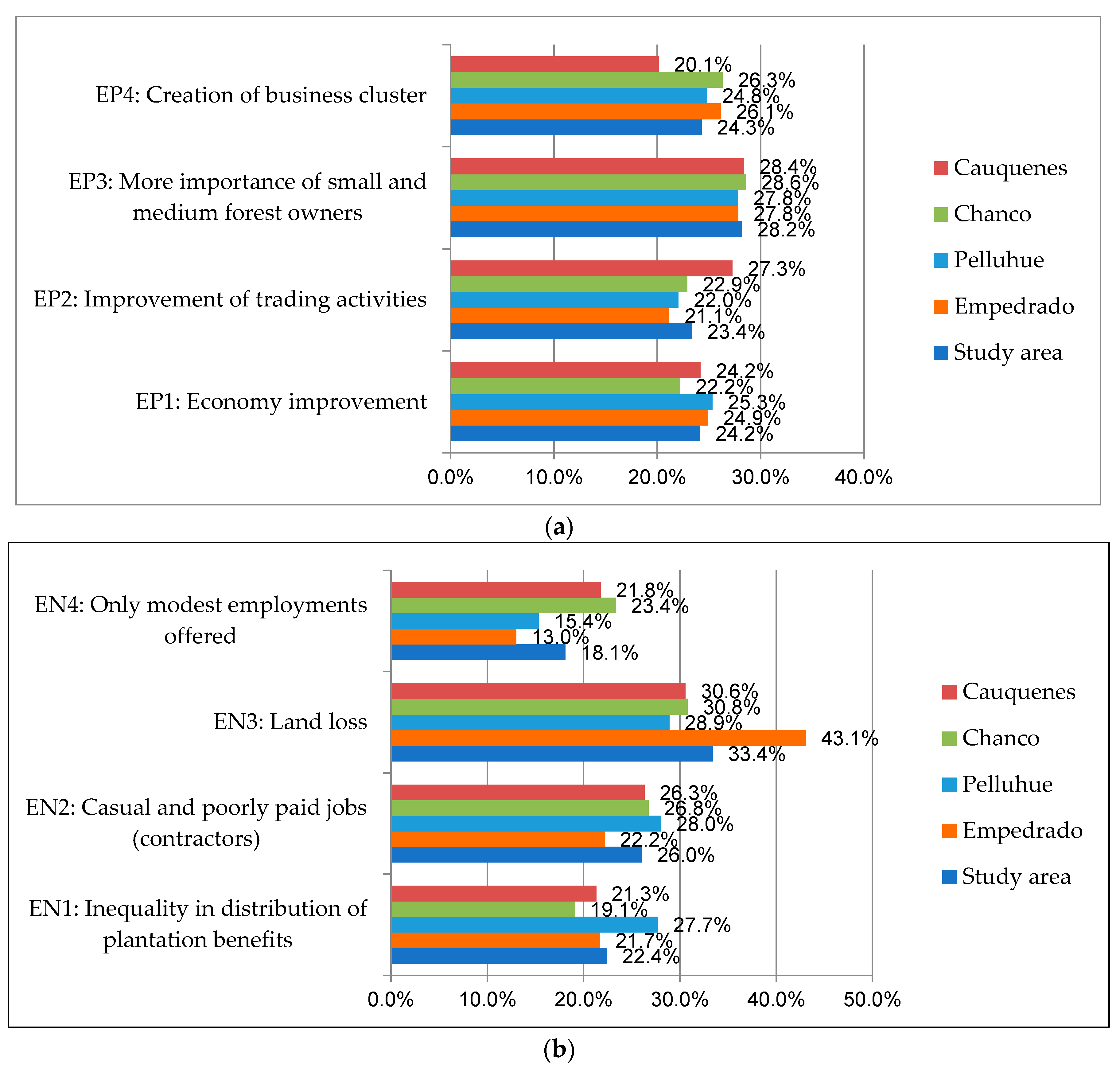
| Municipality | Total Area (ha) | Forest Plantations (ha) | Native Forests (ha) | Mixed Forests (ha) | Forest Plantations (%) |
|---|---|---|---|---|---|
| Cauquenes | 212,662.9 | 86,251.8 | 7620.4 | 3703.3 | 40.6% |
| Chanco | 52,883.2 | 31,269.8 | 1871.7 | 1424.4 | 59.1% |
| Pelluhue | 37,189.9 | 20,636.7 | 5108.9 | 2800.3 | 55.5% |
| Empedrado | 56,624.3 | 41,413.3 | 3827.1 | 1263.3 | 73.1% |
| Sector | Municipalities | Economic Sector | |||
|---|---|---|---|---|---|
| Cauquenes | Chanco | Pelluhue | Empedrado | ||
| Number of enterprises | 849 | 141 | 130 | 15 | Agriculture, livestock, hunting |
| 83 | 19 | 12 | 44 | Silviculture | |
| 23 | 16 | 19 | 6 | Manufacturing wood and paper industries | |
| 153 | 20 | 31 | 10 | Manufacturing not metallic industries | |
| 100 | 16 | 43 | 8 | Hotels and restaurants | |
| Number of employees | 2252 | 281 | 28 | 40 | Agriculture, livestock, hunting |
| 623 | 59 | 150 | 147 | Silviculture | |
| 865 | 23 | 30 | 28 | Manufacturing wood and paper industries | |
| 237 | 15 | 38 | 0 | Manufacturing not metallic industries | |
| 71 | 2 | 34 | 5 | Hotels and restaurants | |
| Type of Externalities | Items | Cronbach’s Alpha |
|---|---|---|
| All | 49 | 0.939 |
| All Positive | 18 | 0.933 |
| All Negative | 31 | 0.953 |
| Positive Environmental | 6 | 0.845 |
| Positive Social | 8 | 0.875 |
| Positive Economic | 4 | 0.870 |
| Negative Environmental | 8 | 0.905 |
| Negative Social | 13 | 0.918 |
| Negative Economic | 10 | 0.907 |
| Externality | Positive | Negative |
|---|---|---|
| Environmental | ||
| MP1 = Soil erosion control | MN1 = Landscape simplification | |
| MP2 = CO2 sequestration | MN2 = Biodiversity decrease | |
| MP3 = Pressure reduction on natural forests | MN3 = Water shortage | |
| MP4 = Increasing of infiltration and water storage | MN4 = Native forest loss | |
| CR = 0.012 | CR = 0.038 | |
| Social | ||
| SP1 = Increased connectivity (improvement of road network) | SN1 = Increase of migration | |
| SP2 = Increase of direct and indirect employment | SN2 = Power asymmetry (employment by contractors) | |
| SP3 = Improvement of livelihood | SN3 = Breaking of the peasant systems (culture, identity) | |
| SP4 = Improvement of infrastructures | SN4 = Gender inequality | |
| CR = 0.019 | CR = 0.013 | |
| Economic | ||
| EP1 = Economy improvement | EN1 = Unequal distribution of plantations benefits | |
| EP2 = Improvement of trading activities | EN2 = Casual and poorly paid jobs (contractors) | |
| EP3 = More importance of small and medium forest owners | EN3 = Land loss | |
| EP4 = Creation of business cluster | EN4 = Only modest employment offered | |
| CR = 0.009 | CR = 0.005 |
| CR | EXTERNALITY | |||||
|---|---|---|---|---|---|---|
| Environmental Positive | Environmental Negative | Social Positive | Social Negative | Economic Positive | Economic Negative | |
| Cauquenes | 0.017 | 0.033 | 0.076 | 0.003 | 0.013 | 0.024 |
| Chanco | 0.005 | 0.051 | 0.026 | 0.015 | 0.029 | 0.019 |
| Pelluhue | 0.070 | 0.024 | 0.049 | 0.023 | 0.015 | 0.010 |
| Empedrado | 0.027 | 0.065 | 0.069 | 0.055 | 0.003 | 0.020 |
© 2018 by the authors. Licensee MDPI, Basel, Switzerland. This article is an open access article distributed under the terms and conditions of the Creative Commons Attribution (CC BY) license (http://creativecommons.org/licenses/by/4.0/).
Share and Cite
Bottaro, G.; Roco, L.; Pettenella, D.; Micheletti, S.; Vanhulst, J. Forest Plantations’ Externalities: An Application of the Analytic Hierarchy Process to Non-Industrial Forest Owners in Central Chile. Forests 2018, 9, 141. https://doi.org/10.3390/f9030141
Bottaro G, Roco L, Pettenella D, Micheletti S, Vanhulst J. Forest Plantations’ Externalities: An Application of the Analytic Hierarchy Process to Non-Industrial Forest Owners in Central Chile. Forests. 2018; 9(3):141. https://doi.org/10.3390/f9030141
Chicago/Turabian StyleBottaro, Giorgia, Lisandro Roco, Davide Pettenella, Stefano Micheletti, and Julien Vanhulst. 2018. "Forest Plantations’ Externalities: An Application of the Analytic Hierarchy Process to Non-Industrial Forest Owners in Central Chile" Forests 9, no. 3: 141. https://doi.org/10.3390/f9030141
APA StyleBottaro, G., Roco, L., Pettenella, D., Micheletti, S., & Vanhulst, J. (2018). Forest Plantations’ Externalities: An Application of the Analytic Hierarchy Process to Non-Industrial Forest Owners in Central Chile. Forests, 9(3), 141. https://doi.org/10.3390/f9030141






